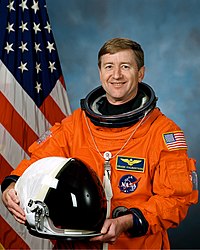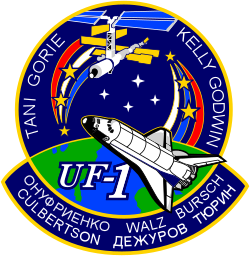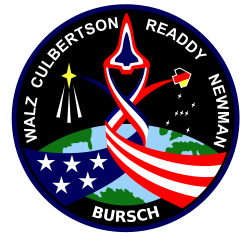Frank L. Culbertson, Jr.
| Frank Lee Culbertson, Jr. | |
 | |
| NASA-astronaut | |
|---|---|
| Född | 15 maj 1949 Charleston, South Carolina |
| Tid i rymden | 143 dagar, 14 timmar, 50 minuter |
| Urvalsgrupp | Astronautgrupp 10 |
| Antal rymdpromenader | 1 |
| Rymdpromenadtid | 5 timmar, 4 minuter |
| Uppdrag | STS‑38, STS‑51, STS‑105, Expedition 3, STS‑108 |
| Uppdragsemblem | |
Frank L. Culbertson, född 15 maj 1949 i Charleston, South Carolina, är en amerikansk astronaut uttagen i astronautgrupp 10 den 23 maj 1984.
Rymdfärder
Källor
”Biographical Data” (på engelska) (PDF). NASA. april 2020. https://www.nasa.gov/wp-content/uploads/2016/01/culbertson_frank.pdf?emrc=d8c5ef. Läst 22 juni 2024.
- ^ ”Expedition 3” (på engelska). NASA. https://www.nasa.gov/mission/expedition-3/. Läst 24 februari 2024.
Media som används på denna webbplats
This is the mission patch of STS-108. Space Shuttle Endeavour is seen approaching the International Space Station. Two astronaut symbols represent the crew commanders of both ISS expeditions. The ascending one represents cosmonaut Yury Onufriyenko of Russia. (The ascending astronaut symbol shows a flag of Russia.) The descending astronaut symbol represents Frank Culbertson of the USA. This represents crew rotation, as three stars are depicted on the symbols. The space shuttle crew members are depicted along the border while the ISS crews are depicted along the chevron on the border of the patch.
- This is the insignia for the STS-108 mission, which marks a major milestone in the assembly of the International Space Station (ISS) as the first designated Utilization Flight, UF-1. The crew of Endeavour will bring the Expedition Four crew to ISS and return the Expedition Three crew to Earth. Endeavour will also launch with a Multi-Purpose Logistics Module (MPLM) that will be berthed to ISS and unloaded. The MPLM will be returned to Endeavour for the trip home and used again on a later flight. The crew patch depicts Endeavour and the ISS in the configuration at the time of arrival and docking. The Station is shown viewed along the direction of flight as will be seen by the Shuttle crew during their final approach and docking along the X-axis. The three ribbons and stars on the left side of the patch signify the returning Expedition Three crew. The red, white and blue order of the ribbons represents the American commander for that mission. The three ribbons and stars on the right depict the arriving Expedition Four crew. The white, blue, red order of the Expedition Four ribbon matches the color of the Russian flag and signifies that the commander of Expedition Four is a Russian cosmonaut. Each white star in the center of the patch represents the four Endeavour crew members. The names of the four astronauts who will crew Endeavour are shown along the top border of the patch. The three astronauts and three cosmonauts of the two expedition crews are shown on the chevron at the bottom of the patch.
The STS-105 crew patch symbolizes the exchange of the Expedition Two and Expedition Three crews aboard the International Space Station. The three gold stars near the ascending Orbiter represent the U.S. commanded Expedition Three crew as they journey into space, while the two gold stars near the descending Orbiter represent the Russian commanded Expedition Two crew and their return to Earth. The plumes of each Orbiter represent the flags of the United States and Russia and symbolize the close cooperation between the two countries. The Astronaut Office symbol, a star with three rays of light, depicts the unbroken link between Earth and the newest and brightest star on the horizon, the International Space Station (ISS). The ascending and descending Orbiters form a circle that represents both the crew rotation and the continuous presence in space aboard the ISS. The names of the four astronauts who will crew Discovery are shown along the border of the patch. The names of the Expedition Three and Expedition Two crews are shown on the chevron at the bottom of the patch. The NASA insignia design for Shuttle flights is reserved for use by the astronauts and for other official use as the NASA Administrator may authorize. Public availability has been approved only in the form of illustrations by the various news media. When and if there is any change in this policy, which we do not anticipate, it will be publicly announced.
JSC2001-01342 (21 February 2001) --- Astronaut Frank L. Culbertson, Jr., mission commander (Editor's Note: Named as Expedition Three commander in September of 1999, Culbertson will be joined by two cosmonaut flight engineers representing Rosaviakosmos when they assume seats on the STS-105 mission, scheduled later this year).
STS-38 Mission Insignia
Emblem of Nasa's STS-51 mission.
ISS Expedition 3 Mission patch
It depicts the book of space history, turning from the chapter with the Russian space station Mir and the space shuttle to the next chapter, one that will be written on the blank pages of the future by space explorers working for the benefit of the entire world. Above the book is a layout of what the station will look like when completed, docked with the space shuttle. The Expedition Three crew members – astronaut Frank L. Culbertson, Jr., commander, and cosmonauts Vladimir N. Dezhurov and Mikhail Tyurin, flight engineers – had the following to say about the insignia for their scheduled mission aboard the International Space Station (ISS): “The book of space history turns from the chapter written onboard the Russian Mir Station and the U.S. Space Shuttle to the next new chapter, one that will be written on the blank pages of the future by space explorers working for the benefit of the entire world. The space walker signifies the human element of this endeavor. The star representing the members of the third expedition, and the entire multi-national Space Station building team, streaks into the dawning era of cooperative space exploration, represented by the image of the International Space Station as it nears completion.”






